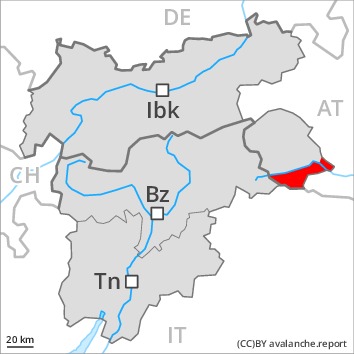
Danger level
Avalanche Problem
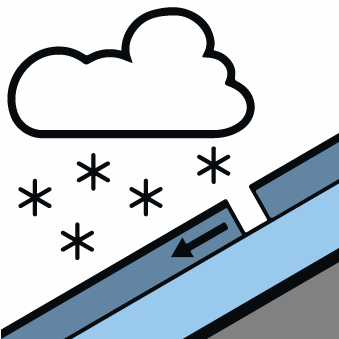 | | New snow |
|  | |  |
 | | Wind-drifted snow |
|  | |  |

A very precarious avalanche situation will be encountered over a wide area.
Naturally triggered avalanches and reports filed by observers confirm a dangerous avalanche situation on steep slopes. Mostly the avalanches are medium-sized. The avalanche prone locations are to be found in all aspects in all altitude zones.
In all altitude zones and on extremely steep slopes more frequent dry loose snow avalanches are to be expected, even medium-sized ones. Slides can occur on cut slopes.
Outside marked and open pistes a dangerous avalanche situation will prevail. Single backcountry tourers can release avalanches very easily, caution is to be exercised on steep slopes also below the tree line.
Large quantities of fresh snow and the wind-drifted snow represent the main danger. Older wind slabs are covered with new snow and therefore difficult to recognise. Great caution and restraint are required.
Snowpack
dp.6: cold, loose snow and wind
dp.8: surface hoar blanketed with snow
Over a wide area 40 to 60 cm of snow, and even more in some localities, has fallen since Friday in all altitude zones. The large quantity of fresh snow as well as the wind slabs to be found in particular above the tree line are lying on the unfavourable surface of an old snowpack in all aspects in all altitude zones. Whumpfing sounds and the formation of shooting cracks when stepping on the snowpack are a clear indication of a weakly bonded snowpack. The weather conditions will prevent a rapid change towards better conditions.
Towards its base, the snowpack is well consolidated.
Tendency
A very precarious avalanche situation will be encountered over a wide area.
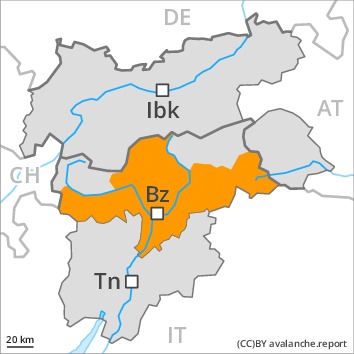
Danger level
Avalanche Problem

Fresh wind slabs represent the main danger.
As a consequence of new snow and a strong wind from southeasterly directions, brittle wind slabs formed in all aspects, caution is to be exercised on steep slopes also below the tree line. Even single backcountry tourers can release avalanches in many places, including medium-sized ones.
The avalanche prone locations are prevalent and are difficult to recognise. Whumpfing sounds and the formation of shooting cracks when stepping on the snowpack can indicate the danger. Extensive experience in the assessment of avalanche danger and great restraint are required. Individual gliding avalanches can also occur.
Snowpack
dp.6: cold, loose snow and wind
dp.8: surface hoar blanketed with snow
The southerly wind has transported the fresh and old snow. The new snow and wind slabs are lying on soft layers in all aspects and in all altitude zones. Towards its base, the snowpack is well consolidated. Stability tests and field observations confirm this situation. The weather conditions will prevent a rapid change towards better conditions.
Tendency
A sometimes critical avalanche situation will prevail.
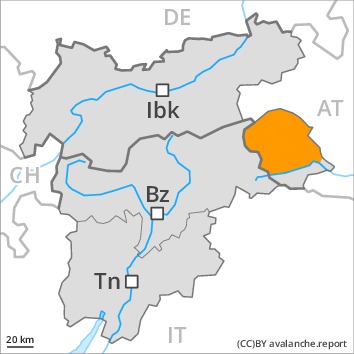
Danger level
 | treeline
|
Avalanche Problem
 | | Wind-drifted snow |
|  | |  |
 | | New snow |
|  | |  |

A precarious avalanche situation will be encountered over a wide area. New snow and wind slabs are to be critically assessed.
Even single backcountry tourers can release avalanches in many places, including medium-sized ones, caution is to be exercised on steep slopes also below the tree line, in the regions exposed to a lot of wind in particular in the regions exposed to heavier precipitation and.
The new snow and wind slabs represent the main danger. Older wind slabs are covered with new snow and therefore difficult to recognise. Great caution and restraint are required.
In all altitude zones and on extremely steep slopes more frequent dry loose snow avalanches are to be expected, even medium-sized ones. Slides can occur on cut slopes. In the regions exposed to heavier precipitation the avalanche danger is a little higher.
Snowpack
dp.6: cold, loose snow and wind
dp.8: surface hoar blanketed with snow
Over a wide area 30 to 40 cm of snow, and even more in some localities, has fallen since Friday in all altitude zones. The southerly wind has transported the fresh and old snow. The new snow and wind slabs are lying on soft layers in all aspects and in all altitude zones. The new snow and wind slabs are lying on surface hoar in some places. Towards its base, the snowpack is well consolidated. Stability tests and field observations confirm this situation. The weather conditions will prevent a rapid change towards better conditions.
Tendency
A precarious avalanche situation will be encountered over a wide area.

Danger level
 | treeline
|
Avalanche Problem
 | | Wind-drifted snow |
|  | |  |
 | | New snow |
|  | |  |

New snow and wind slabs represent the main danger.
On wind-loaded slopes a critical avalanche situation will be encountered in some regions. As a consequence of new snow and a strong wind from southeasterly directions, avalanche prone wind slabs formed in the last two days in all aspects. They can be released easily in all aspects. Caution is to be exercised in particular adjacent to ridgelines and in gullies and bowls. Mostly the avalanches are medium-sized but in many cases easily released. Even single backcountry tourers can release avalanches in many places, including large ones, caution is to be exercised on steep slopes also below the tree line. The prevalence of avalanche prone locations and likelihood of triggering will increase with altitude. Whumpfing sounds and the formation of shooting cracks when stepping on the snowpack can indicate the danger. Caution and restraint are required.
Snowpack
The southerly wind has transported the fresh and old snow. The new snow and wind slabs are lying on soft layers in all aspects and in all altitude zones. Towards its base, the snowpack is well consolidated. Stability tests and field observations confirm this situation. The weather conditions will prevent a rapid change towards better conditions.
Tendency
A sometimes critical avalanche situation will prevail.
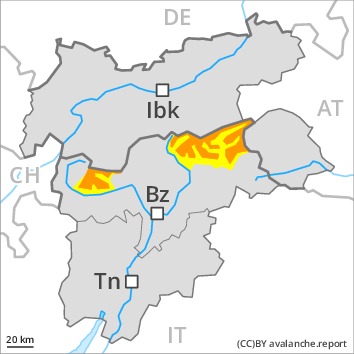
Danger level
 | treeline
|
Avalanche Problem
 | | Wind-drifted snow |
|  | |  |
 | | Wind-drifted snow |
|  | |  |

Backcountry touring calls for extensive experience and restraint.
On wind-loaded slopes a treacherous avalanche situation will be encountered over a wide area. The fresh and somewhat older wind slabs can be released easily in all aspects. Caution is to be exercised in particular adjacent to ridgelines and in gullies and bowls. Mostly the avalanches are only shallow. The avalanche prone locations are prevalent and are difficult to recognise.
Snowpack
dp.6: cold, loose snow and wind
dp.8: surface hoar blanketed with snow
Over a wide area 10 to 20 cm of snow has fallen since Saturday. In some cases new snow and wind slabs are lying on surface hoar. As a consequence of a strong wind from southeasterly directions, easily released wind slabs formed in the last few days in all aspects. Avalanches can be released by small loads and reach medium size. Towards its base, the snowpack is largely stable.
Tendency
Hardly any decrease in avalanche danger. Wind slabs require caution.
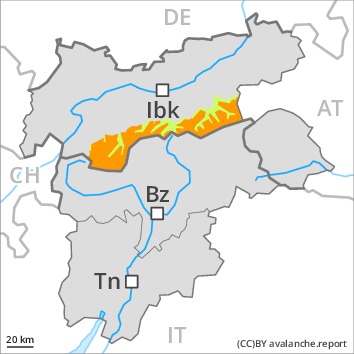
Danger level
 | treeline
|
Avalanche Problem
 | | Wind-drifted snow |
|  | |  |
 | | Persistent weak layer |
|  | |  |

The current avalanche situation calls for experience and restraint.
On wind-loaded slopes a sometimes unfavourable avalanche situation will prevail. The fresh and somewhat older wind slabs can be released by a single winter sport participant in some cases in all aspects. Caution is to be exercised in particular adjacent to ridgelines and in gullies and bowls in areas close to the tree line, as well as above the tree line. Mostly the avalanches are medium-sized. The number and size of avalanche prone locations will increase with altitude. In regions exposed to the foehn wind the avalanche prone locations are more prevalent.
Snowpack
dp.6: cold, loose snow and wind
dp.8: surface hoar blanketed with snow
Over a wide area 5 to 15 cm of snow has fallen since Friday. The southeasterly wind has transported the new snow. The upper section of the snowpack is unfavourably layered. The new snow and wind slabs are lying on surface hoar in some places in all aspects. Towards its base, the snowpack is well consolidated. Stability tests and field observations confirm this situation.
Tendency
Wind slabs are to be evaluated with care and prudence.
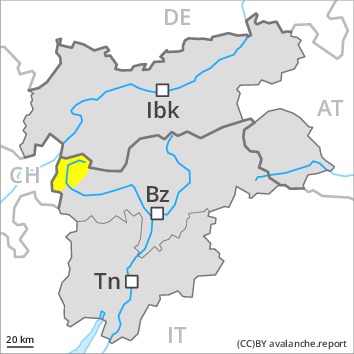
Danger level
 | 2200m
|
Avalanche Problem
 | | Persistent weak layer |
|  | |  |
 | | Wind-drifted snow |
|  | |  |

Weak layers in the old snowpack are treacherous.
Weak layers in the lower part of the snowpack can be released in some places by individual winter sport participants, especially in areas where the snow cover is rather shallow, as well as at transitions from a shallow to a deep snowpack, when entering gullies and bowls for example. This applies especially on steep shady slopes above approximately 2200 m. In addition the sometimes avalanche prone wind slabs should be taken into account. They can be released by a single winter sport participant especially on steep shady slopes above the tree line, caution is to be exercised in particular adjacent to ridgelines and in gullies and bowls. Mostly the avalanches are medium-sized.
Snowpack
dp.6: cold, loose snow and wind
dp.1: deep persistent weak layer
Steep shady slopes: The old snowpack will be prone to triggering in some places. Towards its base, the snowpack consists of faceted crystals. Towards its surface, the snowpack is unfavourably layered and its surface has a crust. In some places relatively hard layers of snow are lying on soft layers. The wind slabs are lying on surface hoar in some places at intermediate and high altitudes.
Tendency
Fresh and older wind slabs require caution.
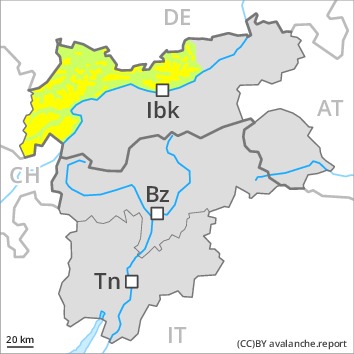
Danger level
 | treeline
|
Avalanche Problem
 | | Wind-drifted snow |
|  | |  |
 | | Persistent weak layer |
|  | |  |

Wind slabs and weakly bonded old snow require caution.
Wind slabs can be released especially on steep shady slopes above the tree line, caution is to be exercised in particular adjacent to ridgelines and in gullies and bowls. The avalanches are rather small. The number and size of avalanche prone locations will increase with altitude.
Weak layers in the lower part of the snowpack can be released in some places by individual winter sport participants. Caution is to be exercised in particular on steep shady slopes above approximately 2200 m, especially in areas where the snow cover is rather shallow, as well as at transitions from a shallow to a deep snowpack, when entering gullies and bowls for example.
Snowpack
dp.6: cold, loose snow and wind
dp.1: deep persistent weak layer
Towards its surface, the snowpack is hard. In some places relatively hard layers of snow are lying on soft layers. This applies in particular above the tree line.
Steep shady slopes: The old snowpack will be prone to triggering in some places. Towards its base, the snowpack consists of faceted crystals.
Tendency
Fresh and older wind slabs require caution.

Danger level
 | treeline
|
Avalanche Problem

Wind slabs require caution.
The fresh and somewhat older wind slabs are in some cases prone to triggering above the tree line, especially on very steep shady slopes adjacent to ridgelines and in gullies and bowls. Mostly avalanches are only small but can be released also by a single winter sport participant. The prevalence of avalanche prone locations and likelihood of triggering will increase with altitude.
Snowpack
dp.6: cold, loose snow and wind
Some snow has fallen in some localities, especially in the south. The southeasterly wind has transported the new snow. In some places wind slabs are lying on soft layers, especially on shady slopes.
Tendency
The avalanche danger will persist.
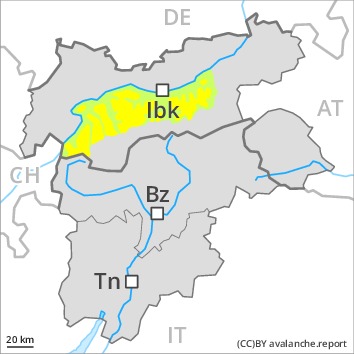
Danger level
 | treeline
|
Avalanche Problem
 | | Wind-drifted snow |
|  | |  |
 | | Persistent weak layer |
|  | |  |

Wind slabs require caution.
The fresh and somewhat older wind slabs can be released by a single winter sport participant in some cases especially on steep shady slopes above the tree line, caution is to be exercised in particular adjacent to ridgelines and in gullies and bowls. Mostly the avalanches are medium-sized. The number and size of avalanche prone locations will increase with altitude.
Weak layers in the lower part of the snowpack can be released in some places by individual winter sport participants. Caution is to be exercised in particular on very steep shady slopes above approximately 2200 m, especially in areas where the snow cover is rather shallow, as well as at transitions from a shallow to a deep snowpack, when entering gullies and bowls for example.
Snowpack
dp.6: cold, loose snow and wind
dp.1: deep persistent weak layer
Some snow has fallen in some localities, in particular in the south. Towards its surface, the snowpack is hard. In some places relatively hard layers of snow are lying on soft layers. The wind slabs are lying on surface hoar in some places at intermediate and high altitudes. Snow profiles confirm this situation.
Steep shady slopes: The old snowpack will be prone to triggering in some places. Towards its base, the snowpack consists of faceted crystals.
Tendency
Fresh and older wind slabs require caution.
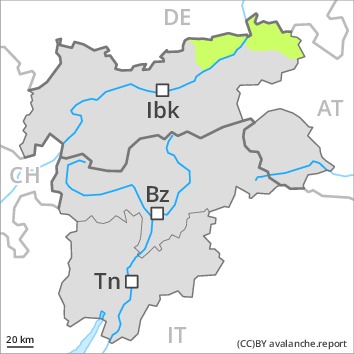
Danger level

Low, level 1.
Wind slabs require caution. This applies on very steep shady slopes, and adjacent to ridgelines above approximately 2000 m. The avalanche prone locations are rare and are easy to recognise.
Snowpack
dp.6: cold, loose snow and wind
In some places wind slabs are lying on soft layers, especially on shady slopes at elevated altitudes. From a snow sport perspective, in most cases insufficient snow is lying.
Tendency
Low, level 1.






























